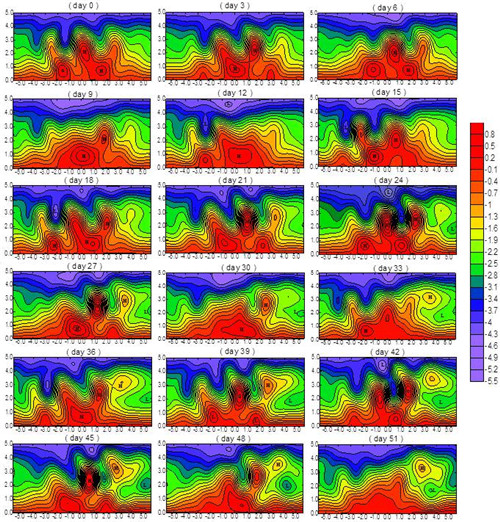Snowstorms in the Middle East and Their Controlling Mechanism
Date:2016-03-09
Large-scale, low-frequency modes have a significant influence on the weather of surrounding areas and the Northern Hemisphere. In the last decade, extreme cold and snowstorms frequently occurred in the Eurasian region, leading to serious economic loss and human injuries. On 13 December 2013, a powerful storm produced historic snowfall in the Middle East (from Jerusalem to parts of Cairo).

Vehicles stranded in snow in Jerusalem on 13 December 2013. AFP PHOTO/AHMAD GHARABLI (http://wapo.st/24OOZ63).
Recently, Prof. LUO Dehai and Dr. YAO Yao from the Institute of Atmospheric Physics (Chinese Academy of Sciences), Prof. S.B. FELDSTEIN from Pennsylvania State University, and Prof. Aiguo DAI from the University at Albany, State University of New York, investigated these Middle East snowstorms and obtained some interesting findings.
On 12 December 2013, Cairo experienced its first snowfall in more than 110 years. Severe winter snowstorms also hit many other countries in the Middle East. The work of Prof. LUO and colleagues revealed that a NE–SW-tilted European blocking (EB) dipole, together with an upstream NAO+ pattern, provided the large-scale environment that led to this snowstorm in December 2013 (Fig.1). The cut-off low downstream of the EB ridge, accompanied by moisture supply from the Mediterranean Sea, created a suitable circulation environment for the outbreak of the snowstorm.

Fig. 1. Horizontal fields for 12 and 13 December 2013. The height contours are drawn from 5400 to 5700 gpm with a 100 gpm interval and the area of precipitation is indicated by green dots. Only the negative temperature anomalies are plotted, with blue shading. The red box represents the Middle East and the red dashed line indicates the jet stream.
Composite results show that the EB-related NAO+ event, with an intense downstream NE–SW-tilted trough over the Middle East, is crucial for cold outbreaks over the Middle East. It transports cold air from high latitudes to low latitudes (in the Middle East) and is usually accompanied by precipitation (or snowfall) in the trough (cyclone) over the Middle East. According to further classification of NAO+ and EB events, it was found that for cold outbreaks over the Middle East, the NE–SW-tilted EB dipole anomaly is the optimal circulation pattern. Results also imply that a strong Atlantic background jet may be an important precursor for snowstorm outbreaks over the Middle East (Fig.2).

Fig. 2. Schematic diagram of the tilting of the NAO+ (left column) and European blocking (right column) dipole anomalies under (a) weak and (b) strong jet background conditions. The “+” ("?") sign denotes the positive (negative) height anomaly. The red solid (dashed) line represents the meridional distribution of the zonal wind over the Atlantic basin (European continent). The right (left)-hand panels “E” (“A”) represent the Europe (Atlantic) region.

Fig. 3. Total streamfunction fields (CI = 0.3) of an NAO+ event obtained from the extended NMI model for strong jet cases. Label H (L) denotes the ridge or anticyclone (trough or cyclone).
Furthermore, a simplified nonlinear multi-scale interaction model was used to investigate the physical mechanism through which the North Atlantic jet affects the EB pattern under the control of an NAO+ event. Results showed that the strength of the North Atlantic jet can modulate the meridional distribution of the zonal wind and cause a different tilting direction of the EB, leading to different weather effects over the Middle East (Fig.3). This work also acted as a supplement to, and refinement of, the previous study on the NAO and blocking.
References
Yao, Y., D. Luo, A. Dai, and S. B. Feldstein, 2016: The positive North Atlantic Oscillation with downstream blocking and Middle East snowstorms: Impacts of the North Atlantic Jet. J. Climate, 29, 1853–1876, doi: 10.1175/JCLI-D-15-0350.1.
Luo, D., Y. Yao, A. Dai, and S. B. Feldstein, 2015: The positive North Atlantic Oscillation with downstream blocking and Middle East snowstorms: The large-scale environment. J. Climate, 28, 6398–6418, doi: 10.1175/JCLI-D-15-0184.1.
Yao, Y., and D. Luo, 2015: Do European blocking events precede North Atlantic Oscillation events? Adv. Atmos. Sci., 32(8), 1106–1118, doi: 10.1007/s00376-015-4209-5.
Luo, D., and Y. Yao, 2014: On the blocking flow patterns in the Euro-Atlantic sector: A simple model study. Adv. Atmos. Sci., 31(5), 1181–1196, doi: 10.1007/s00376-014-3197-1.
Contact:
Dr. YAO Yao, yaoyao@tea.ac.cn
